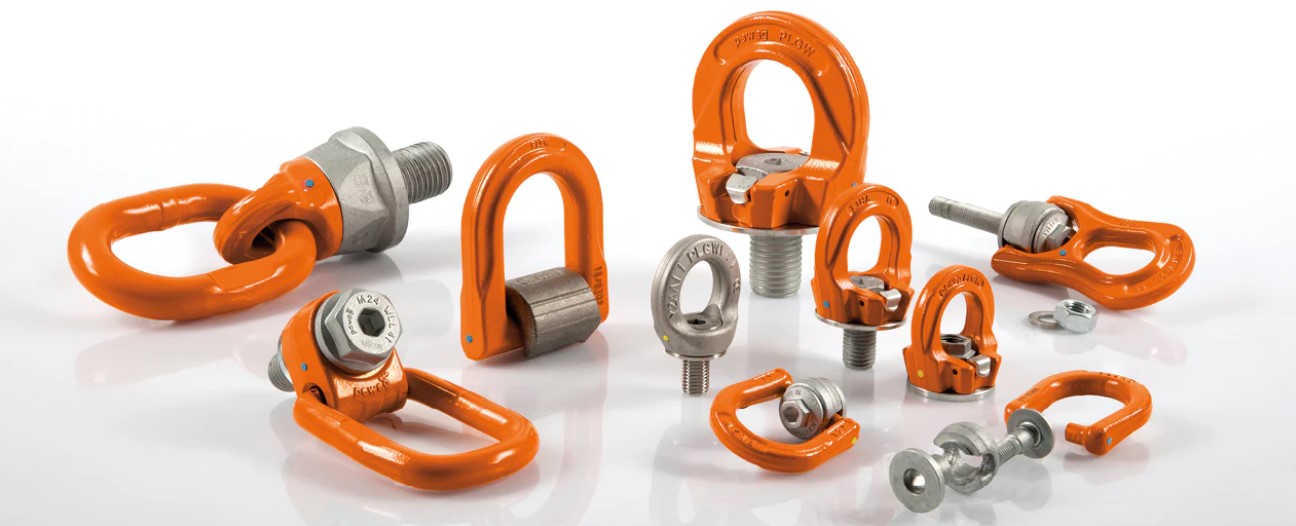Lifting Points and their Applications
Tuesday 21st March 2023

What is a Lifting Point/ Lifting Eye/ Load Ring/Swivel Eye Bolts etc?
Some Salient Features of our Lifting Points:
- Load capacity: Our Lifting points are designed to handle a range of load capacities, from a few pounds to several tons. The load capacity of a lifting point is determined by its size, material, and design.
- Durability: Our Lifting eyes are designed to withstand the rigors of lifting operations and are made of high-strength materials such as alloy steel, stainless steel.
- Corrosion resistance: Pewag Lifting points can be exposed to harsh environments, such as saltwater or chemicals, that can cause corrosion. Pewag Lifting points are designed with special coatings or made from corrosion-resistant materials to withstand these conditions.
- Rotation: We offer Screwable lifting points which are designed to rotate 360 degrees, allowing the load to rotate during lifting operations.
- Swiveling action: Our Swivel lifting points such as PLAW allow easy alignment of the lifting device with the load and can also be used to compensate for off-center loads.
- Ease of installation: Also called load rings they are designed to be easy to install and remove, reducing downtime and increasing productivity.
- Variety of attachment options: Our lifting rings are available with a range of attachment options, such as , bolt-on, and weld-on designs, to accommodate a variety of lifting applications.
- Compliance with safety standards: Pewag lifting eyes are designed to comply with safety standards, such as ISO 9001, ensuring that they meet strict safety requirements.
- Interchangeability: Our Lifting points are often designed to be interchangeable with other lifting points, allowing for greater flexibility in lifting applications and reducing the need for specialized lifting equipment.
Why pewag lifting points are best in the market?
From over half a millennium of company history, the drive for quality and the pursuit of perfection has become a standard that we surpass year after year. This standard has been established from the former chain production to all our product groups. Therefore, the production of the lifting points is driven by these same characteristics to meet our high demands and requirements.
LASHING POINTS
Load lashing or load restraint is a vital component for the safe transport of goods, whether this is by road, rail, air or sea. With our lashing points you can meet all the requirements of EN12640 for safe lashing. Take a look at the lashing points images below.- Purpose: Lifting points are primarily used for lifting loads and providing a secure attachment point for the lifting device, such as a crane or hoist. Lashing points, on the other hand, are used for securing loads to a trailer, ship, or other transport vehicle to prevent movement or shifting during transportation.
- Load Direction: Lifting points are designed to handle loads in a vertical direction, while lashing points are designed to handle loads in a horizontal direction.
- Load Capacity: Lifting points are typically designed to handle heavier loads than lashing points, as the loads being lifted are often much heavier than those being secured for transportation.
- Design: Lifting points are typically designed with a large ring or hook that provides a secure attachment point for the lifting device. Lashing points, on the other hand, may have a smaller attachment point, such as a D-ring, and may be designed to accommodate different types of tie-down straps or chains.
ANCHORAGE POINTS
The anchor points are used for personal fall protection equipment (PPE). The products have been developed and tested in accordance with the stringent safety requirements for personal protection equipment according to EU Directive 89/686/EEC and comply with the EN795:2012 and CEN/TS 16415 standards. The serial number on each anchor point secures best documentation, anual inspection and traceability. Find out more about the pewag anchorage points:
Difference Beiween Lifting Points and Anchorage Points:
- Purpose: Lifting points are primarily used for lifting loads and providing a secure attachment point for the lifting device, such as a crane or hoist. Anchorage points, on the other hand, are used for securing personal fall protection equipment, such as harnesses and lanyards, to prevent falls from height.
- Load Direction: Lifting points are designed to handle loads in a vertical direction, while anchorage points are designed to handle loads in a horizontal or diagonal direction.
- Load Capacity: Lifting points are typically designed to handle heavier loads than anchorage points, as the loads being lifted are often much heavier than those being secured for personal fall protection.
- Design: Lifting points are typically designed with a large ring or hook that provides a secure attachment point for the lifting device. Anchorage points may be designed with a D-ring, bolt hole, or other attachment point that can accommodate different types of fall protection equipment.


